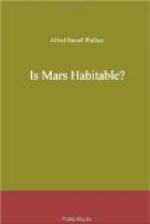This volume is therefore in the nature of a challenge, not so much to astronomers as to the educated world at large, to investigate the evidence for so portentous a conclusion. To do this requires only a general acquaintance with modern science, more especially with mechanics and physics, while the main contention (with which I shall chiefly deal) that the features termed ‘canals’ are really works of art and necessitate the presence of intelligent organic beings, requires only care and judgment in drawing conclusions from admitted facts. As I have already paid some attention to this problem and have expressed the opinion that Mars is not habitable,[2] judging from the evidence then available, and as few men of science have the leisure required for a careful examination of so speculative a subject, I propose here to point out what the facts, as stated by Mr. Lowell himself, do not render even probable much less prove. Incidentally, I may be able to adduce evidence of a more or less weighty character, which seems to negative the possibility of any high form of animal life on Mars, and, a fortiori, the development of such life as might culminate in a being equal or superior to ourselves. As most popular works on Astronomy for the last ten years at least, as well as many scientific periodicals and popular magazines, have reproduced some of the maps of Mars by Schiaparelli, Lowell, and others, the general appearance of its surface will be familiar to most readers, who will thus be fully able to appreciate Mr. Lowell’s account of his own further discoveries which I may have to quote. One of the best of these maps I am able to give as a frontispiece to this volume, and to this I shall mainly refer.
[Footnote 2: Man’s Place in the Universe p. 267 (1903).]
The Canals as described by Mr. Lowell.
In the clear atmosphere of Arizona, Mr. Lowell has been able on various favourable occasions to detect a network of straight lines, meeting or crossing each other at various angles, and often extending to a thousand or even over two thousand miles in length. They are seen to cross both the light and the dark regions of the planet’s surface, often extending up to or starting from the polar snow-caps. Most of these lines are so fine as only to be visible on special occasions of atmospheric clearness and steadiness, which hardly ever occur at lowland stations, even with the best instruments, and almost all are seen to be as perfectly straight as if drawn with a ruler.
The Double Canals.
Under exceptionally favourable conditions, many of the lines that have been already seen single appear double—a pair of equally fine lines exactly parallel throughout their whole length, and appearing, as Mr. Lowell says, “clear cut upon the disc, its twin lines like the rails of a railway track.” Both Schiaparelli and Lowell were at first so surprised at this phenomenon that they thought it must be an optical illusion, and it was only after many observations in different years, and by the application of every conceivable test, that they both became convinced that they witnessed a real feature of the planet’s surface. Mr. Lowell says he has now seen them hundreds of times, and that his first view of one was ‘the most startlingly impressive’ sight he has ever witnessed.




